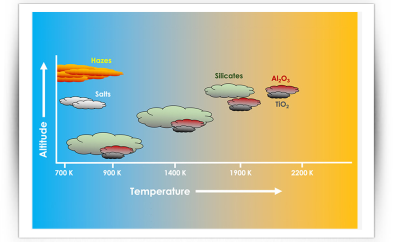| Giant planets in our solar systems and circumnavigating different stars have colorful clouds dissimilar to anything on Earth, and the gas monsters circling near their stars - also called hot Jupiters - brag the most limit. A group of astronomers from the United States, Canada and the United Kingdom have now concocted a model that predicts which of the numerous kinds of proposed clouds, from sapphire to smoggy methane dimness, to expect on hot Jupiters of various temperatures, up to a great many degrees Kelvin. Shockingly, the most well-known sort of cloud, expected over a huge scope of temperatures, should comprise of fluid or strong drops of silicon and oxygen, as liquefied quartz or liquid sand. On cooler hot Jupiters, beneath around 950 Kelvin (1,250 degrees Fahrenheit), skies are overwhelmed by a hydrocarbon fog, basically brown haze.
The model will help stargazers contemplating the gases in the environments of these bizarre and far off universes, since clouds meddle with estimations of the barometrical creation. It could likewise assist planetary researchers with understanding the climates of cooler monster planets and their moons, for example, Jupiter and Saturn's moon Titan in our own close planetary system. "The sorts of clouds that can exist in these hot environments are things that we don't actually consider as clouds in the close planetary system," said Peter Gao, a postdoctoral individual at the University of California, Berkeley, who is first creator of a paper depicting the model that seemed May 25 in the diary Nature Astronomy. "There have been models that anticipate different creations, yet the place of this investigation was to survey which of these arrangements really matter and contrast the model with the accessible information that we have." But while a few planets appear to have clear airs and clear spectroscopic highlights, many have clouds that totally block the starlight sifting through, forestalling the investigation of gases underneath the upper cloud layers. The arrangements of the gases can tell space experts how exoplanets structure and whether the structure squares of life are available around different stars.
|
To clarify these perceptions, cosmologists have proposed numerous peculiar sorts of clouds, made out of aluminum oxides, like corundum, the stuff of rubies and sapphires; liquid salt, like potassium chloride; silicon oxides, or silicates, similar to quartz, the primary segment of sand; sulfides of manganese or zinc that exist as rocks on Earth; and natural hydrocarbon compounds. The clouds could be fluid or strong mist concentrates, Gao said. Future perceptions, like those by NASA's JWST, booked for dispatch inside a couple of years, ought to have the option to affirm these forecasts and maybe shed light on the secret cloud layers of planets nearer to home. Gao said that comparative extraordinary clouds may exist at profundities inside Jupiter or Saturn where the temperatures are near those found on hot Jupiters.
https://www.sciencedaily.com/releases/2020/05/200526161113.htm
 *Image Source: http://spaceref.com/astronomy/astronomers-create-cloud-atlas-for-hot-jupiter-like-exoplanets.html
*Image Source: http://spaceref.com/astronomy/astronomers-create-cloud-atlas-for-hot-jupiter-like-exoplanets.html |